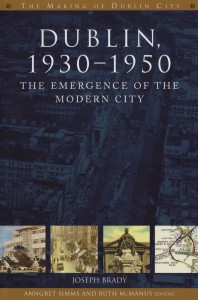The emergence of the modern city
In this, the fifth volume in the series, Joe Brady sets out to uncover and reconstruct the city at a pivotal time in the 1930s and 1940s when it was reasserting its role as a capital city, with all that this entailed in terms of governance and civic improvement. Dublin – the emergence of the modern city brings to life a period in Dublin’s evolution which, although partially within living memory, seems in many ways to be as remote from the present as the depiction of medieval property boundaries or tenement dwellings of earlier volumes. One of the noteworthy features of this book is the way in which it debunks popular memories, or mis-rememberings, of the past. For example, it carefully teases out the debates surrounding the proposed Roman Catholic cathedral which was mooted for Merrion Square, it demonstrates the ways in which the capital city survived – and sometimes thrived – during the Emergency, and it shows how traffic congestion is not a new issue for Dublin.
The book opens with a profile of the city which draws on census data and reveals the complex population, housing, occupational and religious structure of the city. These elements are further elucidated in an appendix. Successive chapters then take on the management and urban governance of the city, the question of civic improvement, housing, transport, shopping and tourism. Dublin – the emergence of the modern city is illustrated with maps, photographs and contemporary cartoons, all of which help to convey the lived experience of the city. The reader will discover a city that is at once familiar and strange, where people went about their business in the shadow of war, but – like today – enjoyed the distractions of shopping on Henry Street and Grafton Streets.
Previous volumes discussed the formal forces shaping the city, in terms of the efforts of the Wide Streets Commissioners in the eighteenth and nineteenth centuries, as well as the early efforts at modern town planning represented by the work of Patrick Abercrombie. This book returns to the issue of formal town planning and further develops our understanding of the way in which the city was governed in this formative period. The ongoing issue of Dublin’s independently-governed suburbs was finally addressed in the 1930s and in this volume we learn how the townships (later urban districts) of Pembroke and Rathmines finally, and reluctantly, joined the city. The tendency for the city to outgrow its formal boundaries and the problems raised by its incoherent system of local government led to proposals to extend the city’s government by way of a Metropolitan Corporation. As with many subsequent efforts to plan for the city as a region, the proposals did not come to fruition, but the reader will find interesting parallels between past and present, as this is an issue which persists to the present day.
While the city was still recovering from the tribulations of 1916 and the subsequent unsettled political period, attention was now being turned to civic improvements. This volume explores some of the major set-piece developments of the period, such as the iconic Busáras and Collinstown (now Dublin) Airport, as well as others which were never realised. The relationship between the city and the river Liffey, which has cropped up in previous books in the series, is brought back into focus here with a discussion of the bridges, particularly O’Connell bridge and the replacement for Butt bridge, as well as other challenges to the transportation (and parking!) infrastructure of the city.
In a detailed chapter on suburban growth and development, this book builds on the discussion of Dublin’s suburban expansion which was the focus of the second volume. As well as exploring a variety of suburban locations, including the Mount Merrion development, it shows how the enduring residential patterning of the city arose, in part, due to decisions concerning social housing locations made during the 1930s and 1940s.
To fully understand a city’s character, it is not enough to examine its physical structure. Reconstructing how people lived, in terms of their shopping experience, helps to give a deeper sense of the city as a lived entity. The profile of the main shopping streets provided here returns to a strand which was also seen in the first two volumes of the series. We also learn, through judicious use of contemporary shopping catalogues and other ephemera, about the food and drink available to the population, as well as the degree to which shortages impacted on the city’s shoppers during the Emergency. The final chapter looks at the city through the eyes of the visitor, using a range of official and commercial guides to the city, as well as personal accounts. Together with the preceding chapter, the broad range of sources used here helps to paint a rich and detailed picture of the city in the 1930s and 1940s.
Published in December 2014, it is readily available and may be obtained directly from Four Courts Press.
 |
Dublin, 1930–1950 The emergence of the modern city Joseph Brady Catalogue Price: €29.95 ISBN: 978-1-84682-520-0 November 2014. 498pp; ills |
|
Chapter headings
- A profile of the city
- Management and Governance
- Civic Improvement
- Keeping the city moving
- Suburban growth and development
- The shopping experience
- Visiting and enjoying the city
- Epilogue : into the 1950s





